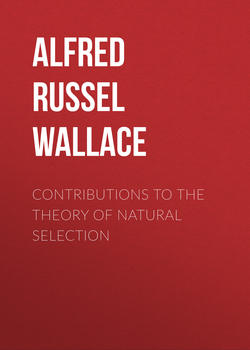Читать книгу Contributions to the Theory of Natural Selection - Alfred Russel Wallace, Alfred Russel Wallace - Страница 31
III.
MIMICRY, AND OTHER PROTECTIVE RESEMBLANCES AMONG ANIMALS
Mimicry among Beetles
ОглавлениеIt may fairly be expected that if these imitations of one creature by another really serve as a protection to weak and decaying species, instances of the same kind will be found among other groups than the Lepidoptera; and such is the case, although they are seldom so prominent and so easily recognised as those already pointed out as occurring in that order. A few very interesting examples may, however, be pointed out in most of the other orders of insects. The Coleoptera or beetles that imitate other Coleoptera of distinct groups are very numerous in tropical countries, and they generally follow the laws already laid down as regulating these phenomena. The insects which others imitate always have a special protection, which leads them to be avoided as dangerous or uneatable by small insectivorous animals; some have a disgusting taste (analogous to that of the Heliconidæ); others have such a hard and stony covering that they cannot be crushed or digested; while a third set are very active, and armed with powerful jaws, as well as having some disagreeable secretion. Some species of Eumorphidæ and Hispidæ, small flat or hemispherical beetles which are exceedingly abundant, and have a disagreeable secretion, are imitated by others of the very distinct group of Longicornes (of which our common musk-beetle may be taken as an example). The extraordinary little Cyclopeplus batesii, belongs to the same sub-family of this group as the Onychocerus scorpio and O. concentricus, which have already been adduced as imitating with such wonderful accuracy the bark of the trees they habitually frequent; but it differs totally in outward appearance from every one of its allies, having taken upon itself the exact shape and colouring of a globular Corynomalus, a little stinking beetle with clubbed antennæ. It is curious to see how these clubbed antennæ are imitated by an insect belonging to a group with long slender antennæ. The sub-family Anisocerinæ, to which Cyclopeplus belongs, is characterised by all its members possessing a little knob or dilatation about the middle of the antennæ. This knob is considerably enlarged in C. batesii, and the terminal portion of the antennæ beyond it is so small and slender as to be scarcely visible, and thus an excellent substitute is obtained for the short clubbed antennæ of the Corynomalus. Erythroplatis corallifer is another curious broad flat beetle, that no one would take for a Longicorn, since it almost exactly resembles Cephalodonta spinipes, one of the commonest of the South American Hispidæ; and what is still more remarkable, another Longicorn of a distinct group, Streptolabis hispoides, was found by Mr. Bates, which resembles the same insect with equal minuteness,—a case exactly parallel to that among butterflies, where species of two or three distinct groups mimicked the same Heliconia. Many of the soft-winged beetles (Malacoderms) are excessively abundant in individuals, and it is probable that they have some similar protection, more especially as other species often strikingly resemble them. A Longicorn beetle, Pæciloderma terminale, found in Jamaica, is coloured exactly in the same way as a Lycus (one of the Malacoderms) from the same island. Eroschema poweri, a Longicorn from Australia, might certainly be taken for one of the same group, and several species from the Malay Islands are equally deceptive. In the Island of Celebes I found one of this group, having the whole body and elytra of a rich deep blue colour, with the head only orange; and in company with it an insect of a totally different family (Eucnemidæ) with identically the same colouration, and of so nearly the same size and form as to completely puzzle the collector on every fresh occasion of capturing them. I have been recently informed by Mr. Jenner Weir, who keeps a variety of small birds, that none of them will touch our common “soldiers and sailors” (species of Malacoderms), thus confirming my belief that they were a protected group, founded on the fact of their being at once very abundant, of conspicuous colours, and the objects of mimicry.
